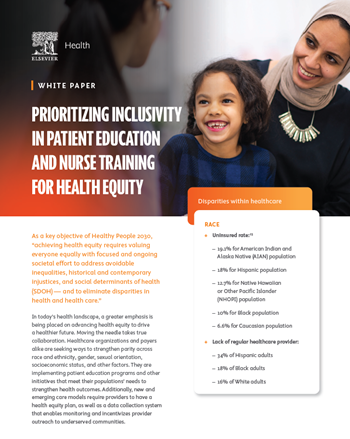Prioritizing Inclusivity in Patient Education and Nurse Training for Health Equity
A greater emphasis is being placed on advancing health equity to drive a healthier future.
In today’s landscape, healthcare organizations and payers alike are seeking ways to strengthen parity across race and ethnicity, gender, sexual orientation, socioeconomic status, and other factors. They are implementing patient education programs, nurse training, and other initiatives that meet their populations’ needs to strengthen health outcomes.
Inequitable access to healthcare and unaddressed SDOH have far-reaching impacts. In fact, racial disparities alone cost the U.S. an estimated $135 billion in excess medical costs and lost productivity each year.
Effective communication is a pivotal factor influencing social determinants of health. According to a study by the Milken Institute, 88% of U.S. adults have limited health literacy which impairs patients’ ability to understand “the why” behind their care and make informed decisions about their health. It also hinders patients’ care compliance.
"As we understand and address the inequities, structural racism, and injustices experienced by marginalized populations we serve, health equity has become a watchword of modern health care.” Nkem Chukwumerije, MD, a national leader for equity, inclusion, and diversity at the Permanente Federation in a Harvard Business Review article.
By fostering an understanding of cultural sensitivity, health literacy, and social determinants of health, healthcare providers can significantly enhance the quality of care for all patients, but especially marginalized individuals.
In today’s landscape, healthcare organizations and payers alike are seeking ways to strengthen parity across race and ethnicity, gender, sexual orientation, socioeconomic status, and other factors. They are implementing patient education programs, nurse training, and other initiatives that meet their populations’ needs to strengthen health outcomes.
Inequitable access to healthcare and unaddressed SDOH have far-reaching impacts. In fact, racial disparities alone cost the U.S. an estimated $135 billion in excess medical costs and lost productivity each year.
Effective communication is a pivotal factor influencing social determinants of health. According to a study by the Milken Institute, 88% of U.S. adults have limited health literacy which impairs patients’ ability to understand “the why” behind their care and make informed decisions about their health. It also hinders patients’ care compliance.
"As we understand and address the inequities, structural racism, and injustices experienced by marginalized populations we serve, health equity has become a watchword of modern health care.” Nkem Chukwumerije, MD, a national leader for equity, inclusion, and diversity at the Permanente Federation in a Harvard Business Review article.
By fostering an understanding of cultural sensitivity, health literacy, and social determinants of health, healthcare providers can significantly enhance the quality of care for all patients, but especially marginalized individuals.

Sponsored by

Download Your Complimentary Copy
Which of the following best describes your organization?
Which of the following best describes your position level?
Which of the following best describes your position function?
By downloading this resource, I agree to sign up to receive newsletters and special offers from HealthLeaders and the sponsor. I understand that I can opt out at any time. Privacy policy.